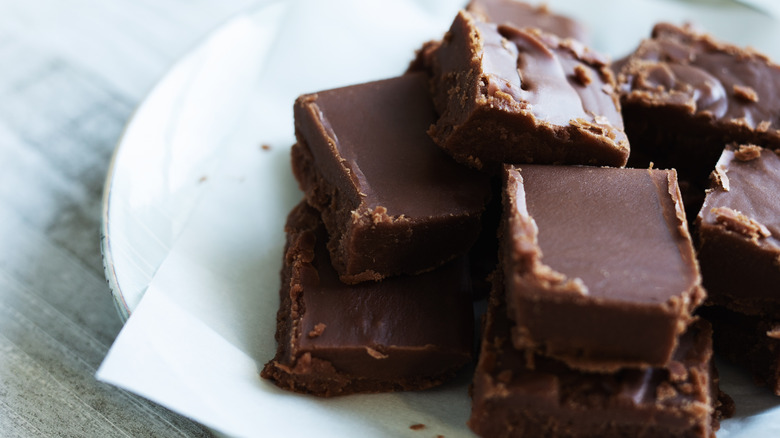The Scientific Reason Alton Brown Uses Corn Syrup In Chocolate Fudge
After getting a bad rap, corn syrup may be doomed to hide in the shadows of table sugar, or to stay stacked in your pantry behind the better-publicized stevia. But there's no doubt that corn syrup can handle the heat, and it stays in the kitchen. Love it or hate it, corn syrup is a dynamic feature of the culinary landscape. It's the answer to stabilizing homemade simple syrup, a key ingredient for stovetop caramel, and the route to achieving a glass-like cookie glaze. We don't know about you, but we're not ditching it anytime soon.
Alton Brown seems to have a similar mindset, or at least he did when he decided to share his chocolate fudge secrets. Alton Brown found corn syrup a supreme option for making chocolate fudge, more likely to turn out a smoother candy than table sugar. In his words, corn syrup is "composed of glucose ... not the same kind of sugar as sucrose, which is what the white table sugar is made of."
Alton Brown is, of course, right — the chemical name for table sugar is sucrose. But sucrose is also fundamentally made up of glucose and fructose molecules. The difference that counts is that corn syrup is an inverted sugar, or a sugar that is hydrolyzed and broken down into unlinked glucose and fructose molecules, whereas sucrose is in its natural state of linked glucose and fructose molecules. Because they're not linked anymore, there's little chance of the molecules in corn syrup reattaching to form crystals.
Corn syrup: the inhibitor of crystallization
Crystallization occurring at the wrong stage of fudge preparation is a major mishap. It's akin to skipping the bloom period for coffee grounds or using baking ingredients at the wrong temperature. Sure, you'll get fudge, but it won't stand the scrutiny of confectionery purists. They'll see the faults before they feel them; a grainy fudge terrain threatening to fracture into crumbs. A missing sheen masked by a dull, matte film. If you're lucky, your fudge will still taste delicious and may be salvaged by re-melting it in water.
By replacing table sugar with corn syrup, Alton Brown solves a major confectionery issue. Sucrose in fudge is prone to crystallization, but adding corn syrup to it delays this process and results in smaller sugar crystals forming. That's why corn syrup is referred to as an interferent or crystal inhibitor in the realm of candy-making.
But since fudge is a crystalline candy, we still require it to form crystals at some point and encourage it to do so after the softball stage (234 degrees Fahrenheit). At this point, Brown insists that you turn off the heat and let the fudge's temperature reduce to 110 degrees Fahrenheit. Then, whip out a wooden spoon and stir the fudge sauce quickly so that it forms tiny crystals. The result? Lustrous chocolate fudge with a perfect, silky-smooth finish.

